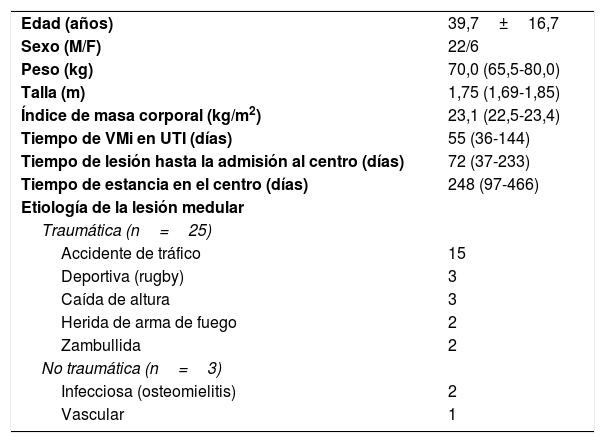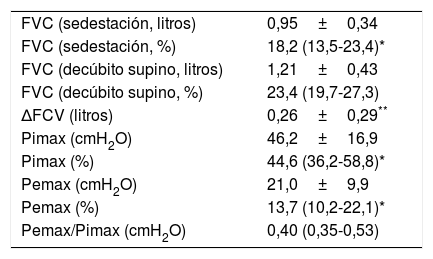La lesión medular (LM) es una entidad devastadora que genera importante discapacidad. La evolución motora y la respiratoria tienen impacto humano y social. Se analizaron aspectos demográficos, evolución respiratoria, motora y el equipamiento necesario al alta en un centro de desvinculación de ventilación mecánica y rehabilitación (CDVMR).
Materiales y métodosEstudio observacional, descriptivo y retrospectivo de historias clínicas entre enero de 2002 y diciembre de 2018. Se incluyeron pacientes con LM cervical, traqueostomía y ventilación mecánica invasiva. Se obtuvieron: capacidad vital forzada (sedestación, decúbito supino), presiones inspiratorias y espiratorias máximas, ASIA y Spinal Cord Independence MeasureIII (SCIMIII).
ResultadosDe 1.603 pacientes, el 3,1% tenían LM y 28 reunieron el criterio de inclusión. Los niveles más frecuentes (17/28) fueron C4-C5, 21/28 tenían ASIAA, 19 no cambiaron el grado de lesión ni la puntuación en el SCIMIII. Fueron desvinculados 22/28 pacientes y 15/28 fueron decanulados. Veinticuatro pacientes alcanzaron el alta domiciliaria. El mayor cambio en el SCIMIII fue en el componente5 del dominio respiración y manejo esfinteriano, relacionado exclusivamente con la desvinculación del ventilador y la presencia de traqueostomía. Al alta, 23/24 pacientes fueron equipados con dispositivos de asistencia respiratoria y motora.
ConclusionesLas LM representan un bajo porcentaje de admisión a CDVMR, y casi la totalidad fueron de origen traumático. La mayoría de los pacientes con ASIAA permanecieron en el mismo grado de severidad. La evolución respiratoria tuvo mayores cambios, mientras que la motora presentó cambios marginales. Al alta, la mayoría de nuestros pacientes necesitaron equipamiento motor y respiratorio.
Spinal cord injury (SCI) is a devastating entity that generates substantial disability. The outcome of respiratory and motor features has an impact in human and social well-being. We analyzed demographic characteristics, motor and respiratory outcomes, and determined equipment needs at discharge in a weaning and rehabilitation center.
Material and methodObservational, descriptive and retrospective study of medical records between January 2002 and December 2018. Tracheostomised cervical SCI patients with invasive mechanical ventilation were included. Forced vital capacity (upright and supine), maximal inspiratory and expiratory pressures, ASIA and Spinal Cord Independence MeasureIII (SCIMIII) were obtained.
ResultsOf 1603 patients, 3.5% had SCI, and 28 met the inclusion criteria. The most frequent level of injury was C4-C5 (17/28), 21/28 had ASIAA classification, and 19 showed no change in either the ASIA or the SCIM score. In all, 22/28 patients were weaned, while 15/28 were decannulated. Twenty four patients were discharged to home. The most relevant change in SCIMIII was in the 5th component of respiration and sphincter subscale, related to weaning and tracheostomy. At discharge, 23/24 patients needed both respiratory and motor aids.
ConclusionsThe admission rate of SCI patients was low in our weaning and rehabilitation center, with almost all being admitted for traumatic causes. Severity remained unchanged in most ASIAA patients. Respiratory recovery was more clinically significant than recovery of motor function. Upon discharge, most of our patients had to be equipped with both respiratory and motor aids.













